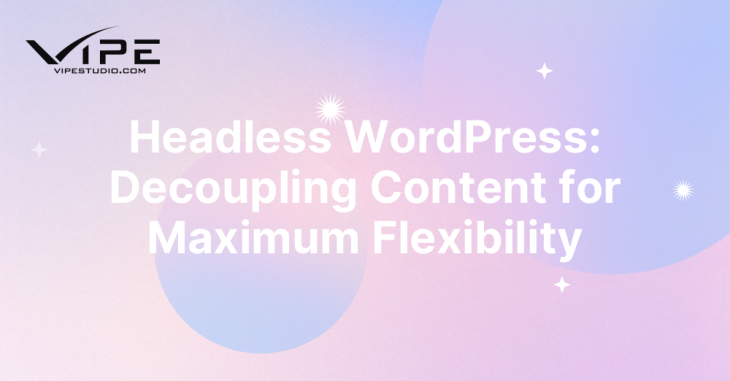Headless WordPress: Decoupling Content for Maximum Flexibility

READING TIME: MIN
Introduction: Rethinking WordPress Architecture
WordPress has long been synonymous with blogging and traditional CMS usage. Yet in recent years, the concept of headless WordPress has gained traction among developers and enterprises seeking greater control over content presentation. Headless WordPress decouples the backend content management system from the frontend display layer, enabling organizations to leverage modern frameworks and deliver content across multiple channels. This approach unlocks flexibility, scalability, and performance improvements previously unattainable with traditional monolithic WordPress setups.
WordPress as a Backend: Infrastructure for Content
In a headless configuration, WordPress functions primarily as a backend content repository. Content creators continue to use familiar tools such as the Gutenberg editor, custom post types, and taxonomies, while developers access content via APIs, including REST or GraphQL. This separation allows frontend teams to choose frameworks like React, Vue, or Angular to design rich, interactive user experiences. Companies often consult WordPress specialists to architect these decoupled systems for both performance and maintainability.
The Advantages of Decoupling
Decoupling the frontend from WordPress offers multiple advantages:

- Performance: Static site generation or frontend frameworks reduce server load and improve page speed.
- Multi-channel Delivery: APIs allow content to appear on web apps, mobile apps, IoT devices, and more.
- Security: Isolating the frontend reduces the attack surface for potential exploits.
- Developer Freedom: Teams can use modern JavaScript frameworks without being constrained by PHP and theme limitations.
This architectural flexibility provides measurable ROI by streamlining development workflows and improving user experience.
Implementation Strategies
Organizations can adopt several strategies when going headless:
- REST API-Based Frontend: Fetch content using WordPress REST endpoints for a decoupled JavaScript application.
- GraphQL Integration: Use the WPGraphQL plugin to query content more efficiently, with precise field selection.
- Static Site Generation: Combine headless WordPress with frameworks like Next.js or Nuxt.js to generate pre-rendered pages, improving speed and SEO.
- Hybrid Approach: Maintain some traditional PHP-rendered pages for legacy content while deploying decoupled sections for high-performance areas.
Challenges of Headless WordPress
Despite its benefits, headless WordPress introduces challenges that teams must address:

- Complexity: Managing separate backend and frontend codebases requires advanced development skills.
- Previewing Content: Traditional previewing mechanisms may not work, necessitating custom solutions for content editors.
- Plugin Limitations: Some plugins depend on PHP rendering and may not function fully in a headless context.
- Hosting Considerations: Decoupled frontends may require different hosting setups, including static site hosting or Node.js environments.
Optimizing APIs for Performance
API efficiency is crucial in headless setups. Organizations should implement strategies such as caching, selective field queries, and batching requests. For example, GraphQL allows developers to request only the data needed for a particular view, reducing payload sizes. REST endpoints can be cached using tools like Redis or Varnish, reducing server load and improving response times. Properly optimized APIs not only enhance performance but also reduce infrastructure costs over time.
Content Modeling for Headless Success
Successful headless projects require careful content modeling. Developers and content creators must collaborate to define custom post types, taxonomies, and metadata structures that support multiple presentation layers. This planning ensures that the same content can be repurposed across websites, apps, and other digital channels. Organizations often engage a WordPress consultancy to establish reusable content schemas and implement editorial workflows that accommodate headless delivery.
SEO Considerations in a Headless Architecture
One common concern with headless WordPress is SEO. When content is decoupled from the traditional PHP-rendered frontend, search engines may not crawl dynamic JavaScript applications effectively. Solutions include server-side rendering (SSR), static site generation, and the use of meta tags through API-driven rendering. Proper SEO integration ensures that decoupled sites maintain visibility and continue to drive organic traffic.

Use Cases for Headless WordPress
Headless WordPress excels in scenarios such as:
- Enterprise websites requiring multi-channel content delivery.
- High-traffic media and publishing platforms needing performance optimization.
- E-commerce stores integrating content and product catalogs across apps.
- Interactive applications with rich front-end experiences built in JavaScript frameworks.
Each use case demonstrates how decoupling content management from presentation maximizes flexibility, performance, and long-term maintainability.
Future Trends: Headless and Beyond
The headless approach is evolving rapidly. Innovations like WordPress as a Service (WPaaS), serverless frontends, and hybrid ecosystems that combine static generation with dynamic rendering are emerging. As brands demand more agility and technical sophistication, headless WordPress will increasingly be a core strategy for delivering performant, scalable, and secure digital experiences.

Conclusion: Embracing the Headless Paradigm
Headless WordPress transforms the traditional CMS into a flexible content hub. By decoupling the backend from the frontend, organizations gain performance, scalability, and developer freedom. Strategic implementation, thoughtful content modeling, and API optimization are key to maximizing ROI. For brands seeking modern, multi-channel experiences, headless WordPress offers a pathway to innovation and long-term success.
Key Takeaways
- Headless WordPress decouples content management from presentation for flexibility.
- APIs, GraphQL, and static site generation are essential tools for modern frontends.
- Performance, multi-channel delivery, and security are major benefits of headless setups.
- Content modeling and editorial workflows must support multiple presentation layers.
- SEO requires careful planning with server-side rendering or static generation.
- Headless WordPress is a forward-looking strategy for scalable and innovative digital experiences.
More on The Topic
- Why Brands Choose WordPress: The ROI Behind Open Source Power
- Multisite Madness: When One Install Rules an Entire Empire
- How WordPress Shapes Digital Democracies One Site at a Time
- The One-Page Website Comeback: Minimalism as a Business Strategy
- Security Theatre: The Myths We Tell Ourselves About WordPress Safety

